Restoring vs Remastering Video
Throughout my tenure at ECG Productions, I’ve cultivated a profound respect for our cinematic heritage. Bringing film classics back to life through either restoring or remastering video isn’t simply a task—it’s an art form that breathes new vigor into our visual past. While these two processes are often perceived synonymously, my experience has taught me that they fulfill distinct roles in the realm of video enhancements. Restoration, to me, is the delicate procedure of returning a film to its original splendor, repairing the impact time has left on its physical reels. On the flip side, remastering is the craft of elevating a film to meet the high definition desires of today’s viewers. Both blend the boundaries of time, seamlessly connecting the rich tapestry of film history with modern technological prowess.
Key Takeaways
- The intrinsic difference between restoring and remastering videos is pivotal in the field.
- Restoration addresses the physical damage sustained by film over time.
- Remastering updates the technical aspects of the film to meet current audience expectations.
- Both methods play a critical role in preserving and enhancing our visual cultural heritage.
- As a professional in the industry, it’s my responsibility to ensure that these classics receive the treatment they deserve.
Understanding the Basics: What Restoration and Remastering Mean
As I delve into the film industry’s commitment to film preservation, I differentiate between two key processes: video restoration basics and the remastering definition. Both are instrumental in the prolongation and revitalization of our cultural visual narratives.
Video restoration is akin to an intricate dance of precision and patience. It involves the rigorous practice of repairing and returning the film to as close to its original condition as possible. Imagine a classic piece of cinema, tainted by the patina of time—scratches, dust, fading—restoration is about meticulously removing these blemishes, often frame by frame.
Video restoration is not merely fixing; it’s about honoring the director’s vision and the film’s place in history.
In contrast, remastering is modern alchemy, turning silver film into digital gold. As technology evolves, the audience’s desire for higher resolution, crisper sound, and richer colors grows. Remastering is updating the technical aspects of a video—whether it’s enhancing the image to make it suitable for high definition screens or reworking the soundtrack to resonate with today’s cinema surround sound systems.
- Physical Healing: Addressing the blemishes on the film’s surface and reconstructive editing.
- Technical Updating: Improving video quality and audio tracks for the current digital formats.
- Preservation: Keeping the original film intact while creating a version that withstands the test of time.
Restoration is an act of love for the art, while remastering is an embrace of potential, ensuring classics are not just viewable but relatable to the audiences of today and tomorrow. Both methodologies are invaluable, a reflection of our dedication to the industry and the audiences we serve.
Film preservation is a commitment to safeguarding not just the physical reels but also the intangible emotions and stories they carry. Thus, by understanding video restoration basics and the remastering definition, we set the stage for a rich journey through cinema’s history and its impending future.
The Technical Side: Diving into Restoration Processes
My journey in film restoration has consistently reinforced one core principle: the essence of every historical film lies within its frames. That’s why frame-by-frame restoration isn’t just a task; it’s a pledge to historical film analysis and visual integrity. I take great pride in combing through every inch of footage, searching for the tell-tale signs of time’s touch — scratches that scar scenes, fading colors that mute moments, and dust particles that veil the vibrancy initially intended by the filmmakers.
Frame-by-Frame Analysis for Historical Films
When I examine a film, each frame presents a story, a piece of a larger narrative mosaic. This meticulous technical restoration process demands an eagle eye and a steady hand, as I pinpoint discrepancies and anomalies that have crept in over decades. Whether I use traditional photochemical means or state-of-the-art digital techniques, the goal remains the same: to restore, not alter, to preserve, not change. The restorative magic happens with light, chemicals, or pixels—whichever serves the film’s needs best.
Each frame is a portal to the past, and it’s my responsibility to ensure that the passage through time is unobstructed by wear and decay.
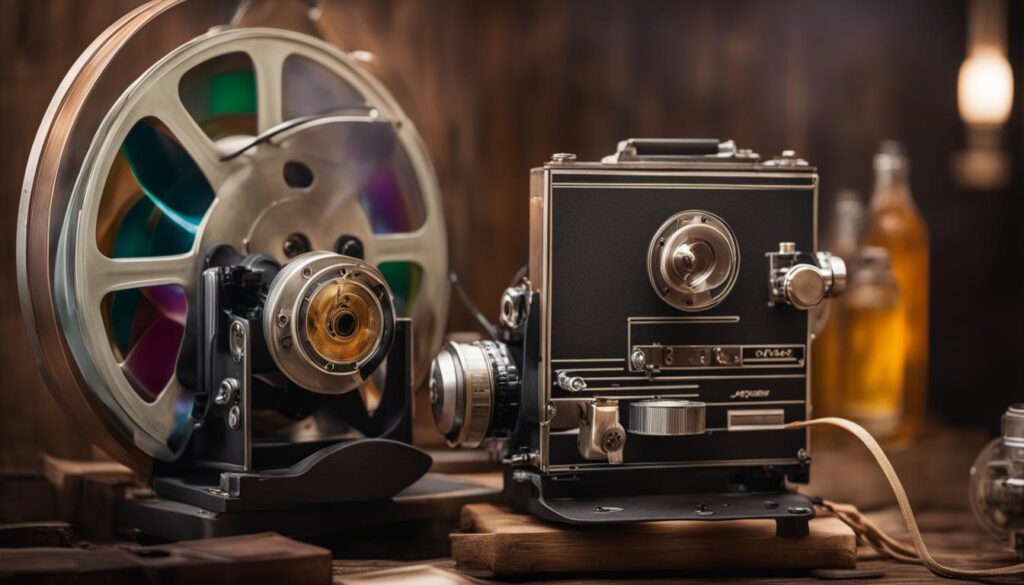
Color Correction Techniques in Restoration
Color degradation is an insidious foe. It sneaks up on films, sapping away the brilliance and dulling the director’s original vision. However, with modern color correction technology, I wield the power to breathe life back into faded frames. This juxtaposition of artistic sensibility with film restoration techniques allows for a rebirth of vibrancy. By adjusting hues, balancing contrast, and refining saturation, I’m able to revivify cinematography with startling clarity and visual impact.
- Inspection for color inconsistencies
- Utilization of digital tools for precision alignment
- Assessment of historical context for accurate hues
- Application of photochemical processes when necessary
Visual enhancement, then, is not simply an alteration—it’s an art in itself. Through these restorative endeavors, classics of yesteryears emerge as treasures of today, each frame a testament to the diligence and dedication to cinematic heritage. As I progress through these technical landscapes, my commitment to each film’s authentic history is further honed, ensuring that the future may always enjoy the true beauty of the past.
Exploring Modern Remastering Techniques
In my committed pursuit of excellence at ECG Productions, I’ve embraced the sheer artistry of modern remastering, which brings timeless classics into the limelight for a new generation of viewers. To me, every frame of a remastered film is a celebration of history meeting modernity. It’s in this transformative journey where SD to HD up-scaling and video resolution enhancement are not merely engineering tasks but an expansion of the film’s legacy.
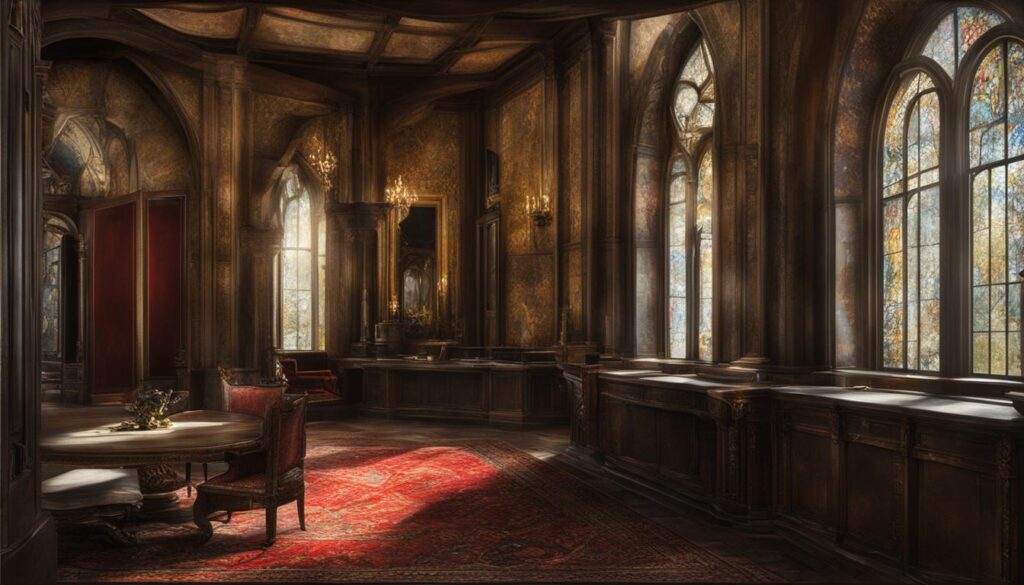
From SD to HD: The Art of Up-Scaling
Moving from the grainy texture of standard definition to the refined clarity of high definition may sound technical, but in truth, it’s akin to revealing the fine brushstrokes of a once-dulled masterpiece. Through SD to HD up-scaling, the subtleties lost in lower resolutions come alive. With cutting-edge software and meticulous attention to detail, it’s possible to uphold the integrity of the original film while presenting it in a quality that meets—and exceeds—today’s audience expectations.
Modern remastering is not just a technical upgrade; it’s a commitment to honoring the visual narrative of remastered films, conveyed in richer and more immersive detail than ever before.
Sound Enhancement in Today’s Remastered Films
A masterful film experience goes beyond the visual—it’s an auditory journey that can touch the soul. Sound enhancement in remastered films means every whispered dialogue, every stirring musical note, and every background nuance is given its chance to resonate with the viewer. With advanced sound design, audio quality improvement breathes life back into classic movies, ensuring that every scene wraps audiences in the intended ambience of the cinematic world.
- State-of-the-art digital audio workstations precisely fine-tune each audio track.
- Background hiss is reduced, bringing forth an elevated clarity.
- Dialogue is sharpened to ensure every word is heard as intended.
- The dynamic range is broadened, enhancing emotional depth and reality.
By incorporating these crucial aspects of sound enhancement, the films that I have the pleasure to work on at ECG Productions are not just heard; they are truly listened to and felt. This is how the classics are reborn—how they continue to capture hearts and imaginations in an evolving digital era.
The Historical Significance of Film and Video Restoration
In my dialogues with fellow enthusiasts and throughout my tenure at ECG Productions, I am often reminded of the profound impact that film history preservation has on our ability to connect with our collective past. As an active participant in this field, I view video restoration significance not as a mere occupation but as a noble mission – ensuring that the story of humanity, as told through the visual arts, continues to inspire and educate.
Film and video restoration is far more than a technical process; it’s the preservation of our cultural heritage, allowing future generations to experience the stories, ideals, and artistic expression of times gone by.
The initiative to restore and uphold the integrity of classic cinema is not just about maintaining reels of film. It’s an ongoing effort to keep the history alive, much like conserving historical monuments or priceless artworks. When we restore a film, we protect the legacy of the artists who created them, the societies they entertained, and the historical periods they represent.
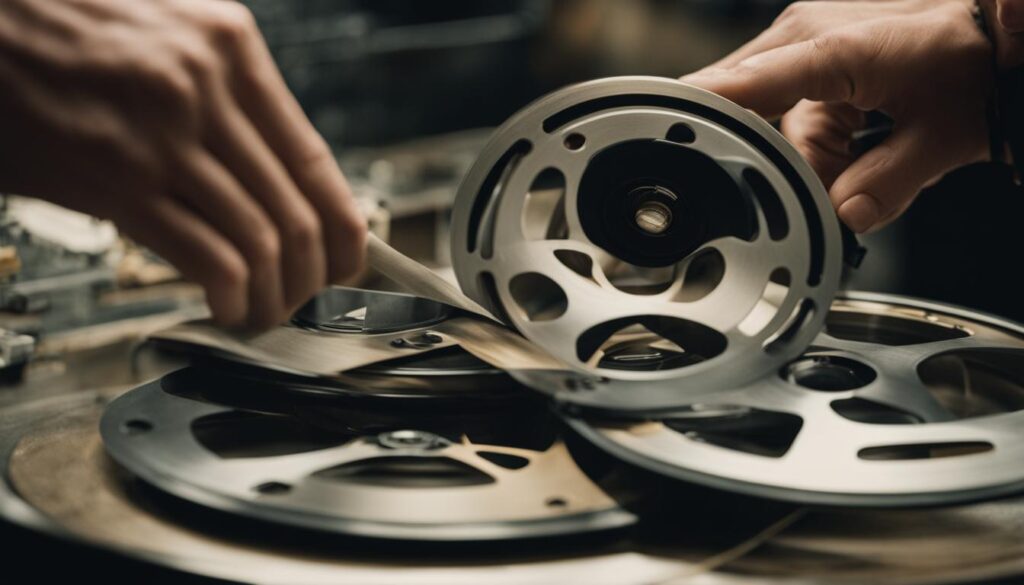
Restoration acts as a bridge, one that extends from the very origins of filmmaking to the thriving industry we see today. Each frame we preserve, each cinematic moment we rescue from the brink of decay, enriches our understanding of where we have come from and forecasts where we are going. To me, this work is a fundamental aspect of our duty to maintain and celebrate cultural heritage.
Consider the iconic moments in motion picture history that may have been lost without this crucial endeavor – the early experimentation of silent films, the significant advancements during the golden era of Hollywood, the groundbreaking international works that expanded the language of cinema. Their rescue from the irreversible damage of time allows us to analyze, appreciate and study them, continuously influencing contemporary directors, scholars, and audiences.
- Preservation celebrates the marks of humanity’s artistic journey.
- Restoration maintains the emotional connection between generations.
- These efforts enlighten us on prior societal values and technological progress.
I affirm, with an unwavering sense of commitment, that to partake in film history preservation is to engage in a work of endless enrichment. It’s a calling that transforms fragile celluloid into perennial milestones of our artistic narrative, ensuring that future eyes and hearts will have the same chance to wander through the visual stories that shaped us.
Examining the Impact of Remastering on Current Media
As I navigate the ever-changing landscape of the film industry, my encounters with the remastering impact on current media never cease to amaze me. With each project I undertake, I am struck by how remastering is not just a tool to rejuvenate older content, but a powerful force that shapes contemporary production. The ripple effect it induces across all facets of the media evolution is staggering, with impressions visible far beyond the immediate sphere of classic cinema.
Remastering is like a breath of fresh air to classics, endowing them with a new lease of life that resonates with contemporary audiences.
In my work, I’ve seen how the enhanced viewing experience has become the norm rather than the exception. Sharper images and superior sound quality set a higher benchmark for new content. This transformative process has irrevocably raised audience expectations—viewers seek out content that matches the clarity and depth of what they have grown accustomed to with remastered classics.
Below, I outline some pivotal aspects where remastering has made its mark:
- **Visual Quality**: The enhanced resolution and meticulous care in color grading lead to images that are vibrant and full of detail, pleasing to the discerning viewer’s eye.
- **Audio Fidelity**: As an advocate for immersive storytelling, I celebrate remastered soundscapes that transform a passive listening experience into an active journey of discovery.
- **Archival Longevity**: By converting analog treasures into digital formats, we ensure that future generations can access these works, thus extending their cultural lifespan.
- **Crossover Appeal**: Classic films that are remastered often attract new audiences, including younger viewers who might have overlooked their magic in less radiant formats.
- **Innovation Inspiration**: Contemporary creators draw insight from the feats of remastering, incorporating similar quality metrics into their new productions.
Within my directorial realm at ECG Productions, the aim is always to craft content that stands the test of technical excellence and historical significance. The meticulous art of remastering not only serves as a foundation for this but also as a beacon guiding the trajectory of media evolution. It redefines the standard, nurturing a culture where quality melds seamlessly with innovation.
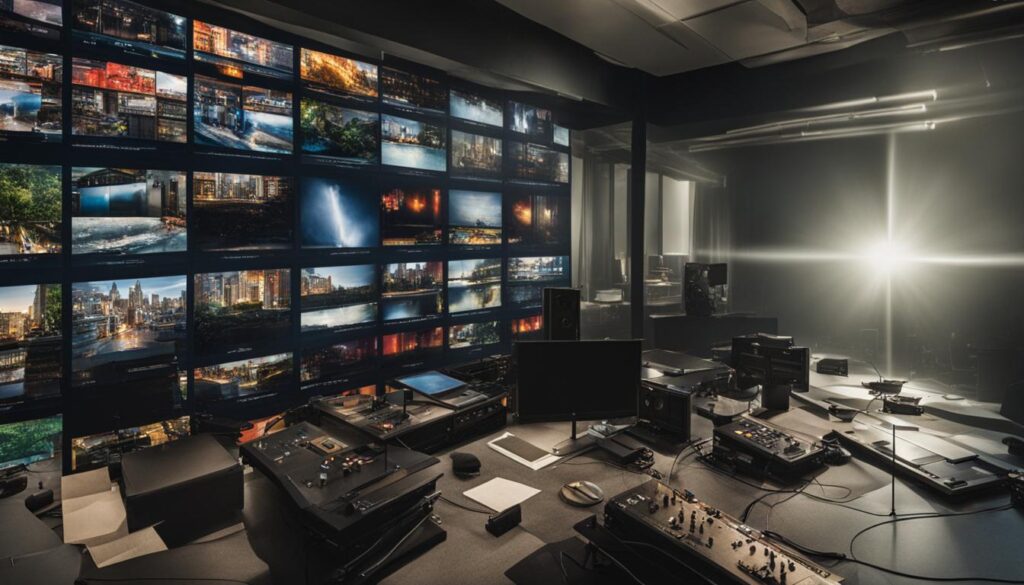
Ultimately, the spread and acceptance of remastering processes have cascaded into all corners of media production, redeeming past narratives and setting the stage for future storytelling brilliance. As I reflect on this journey, my enthusiasm only grows, fortifying my mission to envelop audiences in a viewing experience of unparalleled grandeur—a commitment to excellence that bears the hallmark of both past achievements and future aspirations.
Visual Examples: Before and After the Restorative Magic
The true prowess of restoration magic is most visibly illuminated through before and after comparisons. It’s one thing to discuss the meticulous process, but quite another to showcase the vivid transformations. My journey through film preservation has given me countless opportunities to bear witness to the stark contrasts achieved via photochemical and digital methods. Today, let me share with you a glimpse into this enchanting world.
Photochemical Restoration Visuals
Engaging with photochemical visuals, traditional restoration vividly revives aged masterpieces. As though the film has shed years of wear, each frame emerges clearer, marked by the reinvigoration of original color palettes and the meticulous removal of blemishes. This is the essence of restoration; an alchemy that remains unrivaled in its ability to restore celluloid splendor.
What was once shrouded in the dullness of age is now a visual feast of nostalgia and clarity, reborn through the skillful application of photochemical techniques.
Below, witness the remarkable disparity:
- Before: A dusty, scratched surface; colors that whisper faintly of a story once vivid.
- After: A tableau restored to its original vibrancy; a narrative retold as it was meant to be seen.
Digital Remastering Showcases
When we transition into the realm of digital remastering, the showcase of technology amplifies the transformative effects. It’s a meticulous re-creation where pixels play the part of painters, and resolution refinements are the brush strokes that enhance every detail. In these showcases, what might have been the limits of yesterday’s viewing experience are expanded to meet the expectations of today’s digital consumer.
Through digital remastering examples, we encounter a harmonic blend of art and technology, resulting in a multisensory experience that stands the test of time and technology.
Consider the following restored visuals:
- A landscape once shrouded by the fog of low resolution, now lifted to reveal the intricacies previously unseen.
- Characters that come to life with a crispness that breathes new depth into the narrative, as if speaking directly to the viewer.
The ingenuity of these processes exposes a timeless story retold for modern eyes, without losing the film’s historic essence.

The elegance of capturing the past while ushering it into the future is no simple task, yet it remains an endeavor that thrills me in every frame and speaks volumes of where we can take our cultural heritage next. The captivating synergy of restoration magic and technological advancement lays bare the earnest efforts of those dedicated to film preservation, like myself. And with each project, I am honored to contribute to this tapestry of motion picture marvels, ensuring they endure beyond the flicker of their initial screenings, into the brilliant luminescence of today and beyond.
Suitable Use Cases: When to Restore and When to Remaster
As an industry professional, I frequently encounter the pivotal task of discerning when it’s appropriate to restore filmic treasures and when it’s best to remaster them. The guiding principle in this decision-making lies in understanding the intrinsic cultural value of the content and the current market demand for remastered content. Not all films are created equal in terms of their historical and artistic weight, and as such, not all are candidates for the meticulous process of restoration. Conversely, remastering is often influenced by the potential to captivate and meet the expectations of today’s audiences.
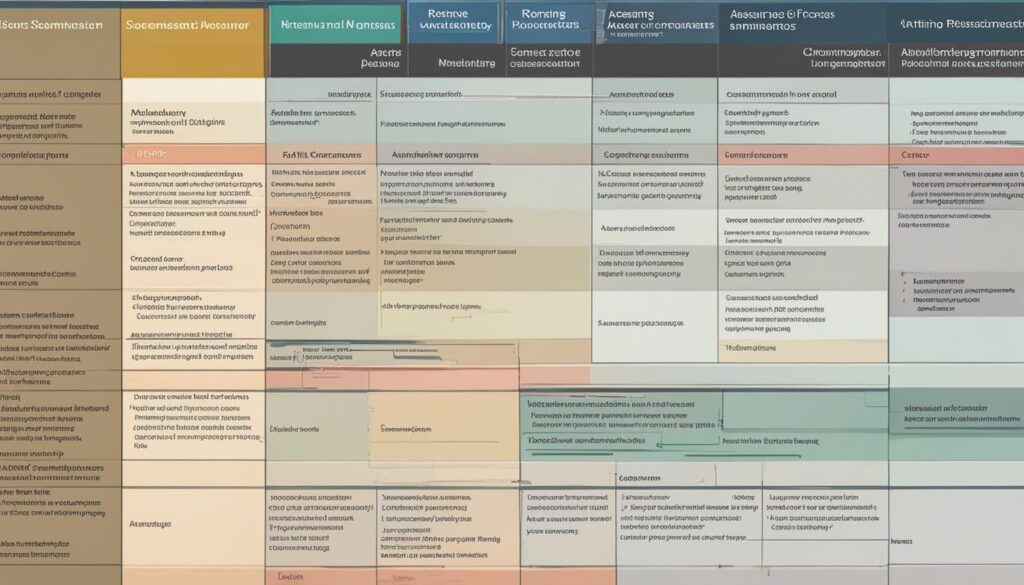
Assessing the Cultural Value for Restoration
In my role at ECG Productions, one of the most challenging and rewarding aspects of my work is conducting significance assessments to determine a film’s eligibility for restoration. The options unfold as we probe the historical context, the impact it had upon its original release, and the legacy it has left within the cultural zeitgeist. Restoration use cases usually involve those pieces that hold considerable historical, artistic, or cultural value. The focus remains steadfast on safeguarding significant works that have contributed to the artistic landscape and ensuring they are preserved for future appreciation.
- Restoring silent film classics that served as cornerstones for modern cinema techniques.
- Preserving works by pioneering directors whose influence shaped the trajectory of film.
- Maintaining films that share essential stories representative of specific eras or movements.
Restoration is more than a technical process; it’s a commitment to retaining the integrity of celebrated achievements in film, endowing them with the respect and care they warrant.
Understanding Market Demand for Remastered Content
When it comes to remastering, I’ve found that audience interest often dictates the path we take. For example, films with enduring popularity or a cult following are prime candidates for remastering as they have demonstrated a market demand that suggests a profitable and culturally enriching venture. In our assessments at ECG Productions, we also consider the potential to introduce these time-tested narratives to a new demographic. Technology enables us to upgrade such content, offering remastered content with enhanced visuals and audio that appeals to the sensibilities of modern audiences.
- Analyzing trends to identify films with ……strengthen their portfolio.
Our passion for film drives us to cater to nostalgia while simultaneously delivering remastered content that aligns with present-day production values and audience expectations.
Technical Aspects: The Equipment Behind the Magic
In the field of cinematic revival, the technical aspects involved in both restoration and remastering are vast and intricate. As an aficionado of film craftsmanship, I relish in the opportunity to shed light on the sophisticated restoration equipment and remastering technology that empowers our industry to renew the films of yesteryear. The fusion of heritage and technology is a delicate dance that produces cinematic treasures for the modern era.
My treasure trove of tools at ECG Productions encompasses various high-grade apparatuses that convert tattered reels into pristine digital masterpieces. The arsenal ranges from ultra-high-resolution scanners capable of digitizing film with outstanding clarity, to color grading suites laden with an array of controls that breathe vibrancy back into faded visuals. Indeed, the technology is a core component of the magic we render daily.
Every piece of equipment tells a story of innovation, a saga of progress that champions the resurrection of cinematic legends.
- Scanners for Film Digitization: These are the gatekeepers, the first step in transforming cellulose to binary, ensuring each frame is captured with the highest fidelity.
- Color Grading Tools: Working hand in hand with restoration specialists, these tools correct imperfections and restore the original hues that time may have altered or eroded.
- Audio Restoration Systems: With these, distorted or muffled sounds are clarified, and ambient nuances are amplified to create an auditory experience that honors the film’s initial release.
This high-tech gear is not a mere investment but an embodiment of our passion for keeping the cinematic flame ablaze. Each device, each software application stands as a testament to our dedication to the art of film, ensuring that these visual epics will continue to enthrall audiences for generations to come.
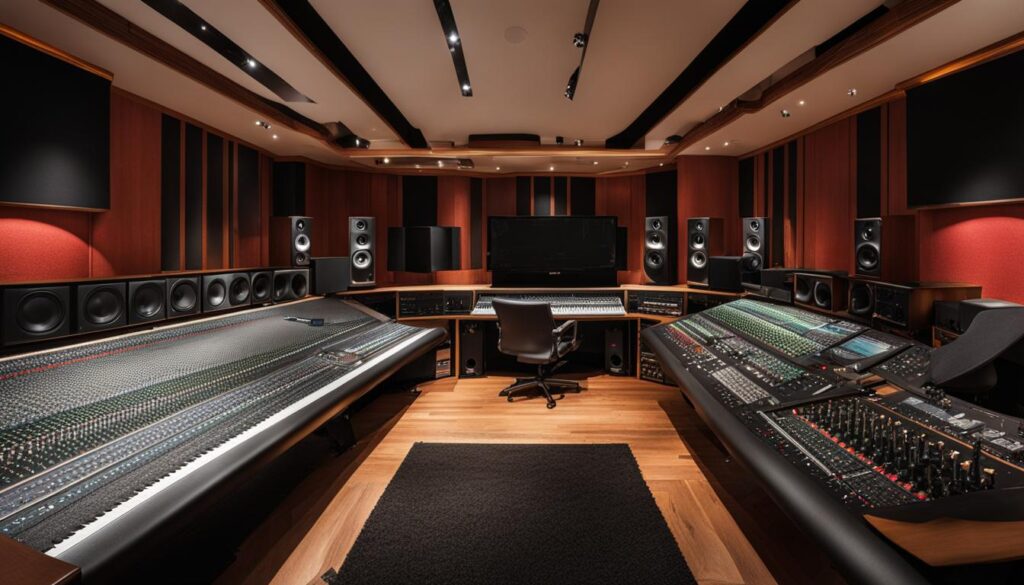
Behind every restored classic or successfully remastered movie lies an ensemble of stellar technology and the skilled curators who wield it. The careful interplay between man and machine is an ode to our industry’s enduring devotion to the motion picture narrative. It is here, among the delicate circuits and software algorithms, where past and present converge to create a future ripe with the seeds of history’s finest cinematic fruits.
These tools are not only investments in our heritage but also in the global story we continue to weave with every project stamped with the seal of ECG Productions.
Audience Perception: How Restoration and Remastering Affect Viewership
In the realm of cinematic experiences, I’ve seen firsthand how the meticulous arts of restoration and remastering can dramatically influence audience perception. Dynamics of viewership are deeply interconnected with how films are presented; whether restored to their historical glory or remastered to meet contemporary appetites. Engaging in these processes is more than a mere technical endeavor—it’s an intricate dance with the past and the future, aimed at captivating the hearts and minds of today’s audiences.
Restoration connects viewers to the authentic past, remastering transports classics into the future—both altering audience perception and enhancing viewership impact.
The magic of a restored film lies in its ability to invoke nostalgia. There’s a profound beauty in witnessing a flickering piece of history brought back to life with its original texture, sound, and color intact, free from the wear of time. The cracks and pops characteristic of old film prints are often lovingly preserved, allowing audiences to immerse themselves in an authentic bygone cinematic experience. Such authenticity not only re-engages those with restored memories of the first release but also stirs curiosity among new viewers, eager to consume media as it was initially experienced.
On the other end of the spectrum, remastering translates to adaptability and relevance in a digital era obsessed with clarity and definition. Enhancing classic films to resonate with modern appeal is a transformative process that sees dusty reels evolve into sharp, vibrant images compatible with today’s high-definition screens. These remastered renditions combine vintage narratives with contemporary expectations, bridging the gap between historical artistic intent and present-day viewing standards.
Introducing these esteemed films to a larger audience is a testament to the enduring power of stories that transcend their media. Whether it invigorates lifelong fans or garners new appreciators, the transition of classic films through restoration or remastering is a strategic nod to the importance of preserving our cinematic heritage while also catering to evolving viewer sensibilities.
Here’s how both mediums affect audience perception and viewership impact:
- Restored films invite introspection and historical appreciation, providing a window into the artistic past and its filmmaking techniques.
- Remastered works spark excitement with their modernized visuals and sound, catering to an audience demanding high-quality entertainment.
- The dichotomy of restored vs remastered offers a diverse portfolio for viewers, ensuring that there is something for everyone regardless of their preferences.
The progressively interconnected world we live in has given rise to a global viewership with a wide range of tastes and inclinations. Films that are either restored or remastered become part of a broader conversation, igniting discussions and fostering a deeper connection spanning multiple generations of viewers. It is this profound impact on audience perception that not only heightens the value of the content but also propels the narratives forward, ensuring their place in the cultural zeitgeist.

Our journey through film preservation is not merely an archivist’s ambition but a strategic embrace of our desire to tell stories that resonate. Whether through the delicate texture of a restored classic or the crispness of a remastered favorite, we renew each tale with the potential to leave an indelible mark on the fabric of our visual culture. It is my privilege, as a guardian of these narratives, to contribute to a legacy that will continue to charm and challenge perspectives for years to come.
Industries Revolving Around Restoration and Remastering
Engaging with heritage conservators has cemented my understanding of restoration’s role as a pivotal element in institutions like museums and archives. The meticulous labor that goes into preserving, restoring, and presenting historical film pieces is not just a commitment to conservation, but a profound contribution to the educational outreach these establishments provide. As a professional in the field, I witness the relentless effort to keep the flames of human creativity alive for public consumption.
The Role of Restoration in Museums and Archives
Time and again, I’ve seen museums and archives implement advanced restoration techniques to maintain and showcase their film collections. These films stand as testaments to diverse cultures, historic milestones, and the evolution of storytelling in visual media. By preserving these artifacts, museums and archives offer a window into the past, allowing us to experience the world as it was seen through the lenses of earlier generations.
Each restored film in these repositories of history serves as an ode to human creativity, meticulously preserved for generations to marvel at and learn from.
- Restoration in museums connects visitors with the authentic visage of our shared history.
- Archives rely on the integrity of restored films to support research and archival projects.
- Both types of institutions maintain a narrative thread that anchors us to the essence of human creativity.
The custodians of cultural heritage understand that restoration is more than saving movies; it’s about preserving the stories and the essence that define who we are.
The Commercial Drive for Remastered Entertainment
In the bustling entertainment industry, there’s a palpable commercial drive for remastered content that I find immensely exciting. Here, remastering serves as a strategic tool to inject new vigor into classic works. It’s not merely about aesthetics; it’s a deliberate tactic to re-introduce legacy content to a saturated market, ultimately prolonging its lifespan and profitability.
Through commercial remastering, classic films and series are given a new lease of life. My production work often draws from this well of timeless content, upgrading it to meet modern standards of quality, thus capturing new revenue streams and expanding fan bases.
Remastered entertainment is a testament to the industry’s innovative spirit, leveraging the past to create a profitable future for classic narratives.
- Increased profitability comes from catering to both nostalgic audiences and curious newcomers.
- The entertainment industry often balances the artistic value with commercial success through strategic remastering.
- By bringing remastered classics to streaming platforms, producers tap into a vein of perpetual viewer interest.
The drive to remaster content reflects a broader trend in the entertainment sector: an ongoing dialogue with our cultural legacy, powered by economic incentives and audience appetites.

Conclusion: Embracing a Luminous Future for Cinema
In the vast and vibrant tapestry of the film industry, the roles of restoring and remastering stand as twin beacons, illuminating the ongoing narrative of our human culture. My role in video production imbues me with a profound sense of pride, as I actively engage in the preservation and enhancement of these artistic expressions. The film industry advancement we witness today is a symphony composed of technology’s greatest marvels and the fervent expertise of those who wield it. This harmonious blend assures us that the future of cinema will continue to dazzle and inspire for generations to come.
The triumphs of video preservation are not merely technical achievements but a testament to our commitment to the art that defines and enriches our lives. Each restored classic and each frame remastered is a victory, a video preservation triumph that allows seminal works to transcend the confines of their eras, echoing through the annals of time. It is through this lens that we view the resplendent future of cinema — bright with possibilities, ripe with innovation, and steadfast in its homage to the genius of our predecessors.
As the curtain falls on each project, I am reminded that the work we do today is the foundation for tomorrow’s masterpieces. With every meticulous restoration and every precise remastering, we weave a legacy that will permeate through the canvas of time, ensuring that the treasures of our shared cinematic journey endure. Eagerly, we stride into this evolving cinematic landscape, where the past’s luster meets tomorrow’s potential, forging a majestic and unyielding testament to the power of storytelling. As the lights dim and the screens brighten, I look forward to the ever-glimmering future of cinema with unbounded enthusiasm and hopeful anticipation.
FAQ
What Are the Key Differences Between Restoring and Remastering Video?
The key differences lie in their objectives and techniques. Restoring is about returning a film to its original state, addressing physical damage and degradation. Remastering, however, is about improving the quality of the video and audio to meet modern standards—such as upgrading resolution and enhancing sound quality.
Why Is Understanding Video Restoration Basics Important?
Understanding the basics of video restoration is essential for appreciating the value of cinematic heritage. It helps one comprehend the painstaking effort that goes into preserving film classics and ensures informed decisions can be made when handling these cultural treasures.
How Is Frame-by-Frame Analysis Used in Historical Film Restoration?
Frame-by-frame analysis is used to meticulously inspect each frame for signs of wear, such as scratches, dust, and fading. This detailed scrutiny is vital for identifying all the issues that need to be addressed to restore a film’s original quality.
What Techniques Are Employed in Color Correction During Film Restoration?
Techniques in color correction can range from photochemical processes to digital intermediates, aimed at refining and matching the film’s original color palette as closely as possible. This is crucial for films that have experienced color degradation over the years.
How Does Modern Remastering Enhance Video Resolution?
Modern remastering enhances video resolution by converting standard definition footage into high definition or 4K resolution. This process involves various techniques such as up-scaling, which increases sharpness and detail without compromising the original’s integrity.
What Sound Enhancements Are Made in Today’s Remastered Films?
Today’s remastered films often receive sound improvements that may include noise reduction, dialogue clarity enhancement, and dynamic range expansion. The goal is to create a more immersive auditory experience for contemporary audiences.
How Does Film and Video Restoration Preserve Cultural Heritage?
Restoration plays a pivotal role in preserving cultural heritage by fixing and protecting historical footage, which helps maintain the original works for future generations to learn from and enjoy.
What Impact Does Remastering Have on Current Media?
Remastering has a significant impact; it helps refresh older content for modern audiences, raising the bar for production quality and influencing expectations for audiovisual experiences in current media.
Can You Provide Visual Examples of Photochemical Restoration?
Visual examples of photochemical restoration often showcase before and after shots that display the removal of visual blemishes, the reintroduction of lost colors, and overall revitalization of the film’s appearance.
What Do Digital Remastering Showcases Illustrate?
Digital remastering showcases illustrate the transformation made possible by technology, such as increased resolution, color grading, and sometimes frame rate adjustments, offering a contemporary touch while maintaining the film’s original feel.
When Should a Film Be Restored?
A film should be restored when it holds significant cultural, historical, or artistic value—and when the physical medium has deteriorated to a point where it might be lost without intervention.
How Is Market Demand Determined for Remastered Content?
Market demand for remastered content is determined by audience interest, the potential for a film to reach new markets or demographics, and its viability in a world where high-definition content is becoming the norm.
What Equipment Is Used in the Restoration and Remastering of Films?
Advanced scanners for film digitization, color grading suites, digital audio workstations, and restoration software are some of the key pieces of equipment used in the restoration and remastering of films.
How Do Restoration and Remastering Impact Audience Perception?
Restoration and remastering significantly impact audience perception by rekindling nostalgia for older films and providing a more engaging experience with improved visuals and sound, which can attract a wider and newer audience base.
What Is the Role of Restoration in Museums and Archives?
In museums and archives, restoration serves to maintain and preserve film as a historical and educational resource, ensuring that these visual records remain accessible and intact for public viewing and study.
Why Is There a Commercial Drive for Remastered Entertainment?
There is a commercial drive for remastered entertainment because it allows the industry to reintroduce classic films and series to the market, prolonging their lifespan and monetizing existing content by tapping into nostalgia and reaching new audiences.

